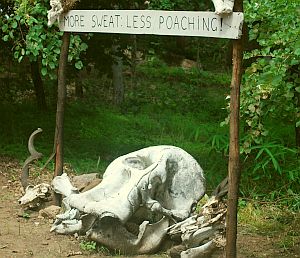Thuma Forest Reserve
Main project of the Wildlife Action Group is the "Thuma Forest Reserve Eco-system Rehabilitation Project". The objective of the Thuma Project is to protect its flora and fauna and to restore its ecological balance in co-operation with the communities around Thuma.
Thuma Forest Reserve has been gazetted in 1926 and covers an area of roughly 19700 ha (197 km2) in the Great Rift Valley Escarpment near Lake Malawi, approximately 80 km from Malawi's capital Lilongwe.
The altitude of Thuma Forest Reserve varies from 575 to 1564 meters (Thuma Mountain) above sea level.
Generally the topography is rugged. The upper levels are covered in Brachystegia woodland (miombo woodland) whilst the lower levels are characterized by mixed low altitude woodland with patches of bamboo.
Thuma is one of a few forest reserves in Malawi which is still home to elephant and buffalo. Other game include greater kudu, bushbuck, Sharpe's grysbok, common duiker, klipspringer, baboon, vervet monkey, bushbaby, leopard, spotted hyena, genet, African civet, honey badger, warthog, bushpig, porcupine and many other smaller species.
But Thuma is not only of interest for this mammals. There is a variety of trees and plants, birds and insects, which have hardly been recorded or studied (see our lists of recorded wildlife).

Serious Disturbance Of The Wildlife In Africa
Besides the poaching of wildlife, Thuma Forest Reserve was, like all other forest reserves in Malawi, under serious threat of deforestation because of illegal tree felling for firewood, charcoal burning and timber plus illegal cutting of bamboo, causing serious habitat degradation and serious disturbance of the wildlife.
In August 1996 the Wildlife Action Group started, in co-operation with the Malawi Department of Forestry, the "Thuma Forest Reserve Eco-System Rehabilitation Project".
A scout and volunteer camp has been established, more than 35 km of roads and tracks for patrolling have been built. Many wire snares have been collected since and over 50 elephant and buffalo pit traps have been destroyed. Several lorry loads of illegal cut fire wood have been confiscated and due to the permanent patrolling, the surrounding community more often buys bamboo now legally and this has increased government's revenue by hundreds of percent.
It hasn't always and sometimes still isn't easy but we are on the right track: Thuma F.R. is now, without doubt, one of the best, if not the best, protected forest reserve in Malawi. W.A.G. emphasizes on training its own scouts to assure 100% dedication and efficiency. And in 2006 W.A.G. has reached the target of employing one scout for almost every 15 km2 of Thuma; a very high protection level compared to most other reserves in Africa. And our scouts do spend their time in the field: about 25 days per month in a row, because that is where a scout should be: in the field, protecting wildlife!
As a result, in the last 10 years poaching pressure in Thuma F.R. has reduced significantly, wildlife numbers are increasing, elephants have returned to Thuma F.R. in 1999 after they left the area due to severe poaching in the 80's, and the buffalos, previously split up in small groups of 3 to 4 animals to escape the poaching pressure, now form herds of up to 30 animals.
At the same time, volunteers from Europe have been deployed to supervise and assist with the construction of roads, scout- and volunteer accommodation as well as conducting game counts, biological surveys and taking part in the scout training.
And by implementing conservation micro-projects in the communities around Thuma, W.A.G. targets to make its conservation efforts to be of the benefit of both people and wildlife!
Thuma Forest Reserve is regaining its beauty and we will continue to preserve Thuma, one of the pearls of Malawi!







